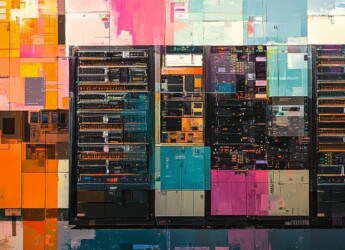Editor’s Note: This article is essential reading for professionals in cybersecurity, information governance, and eDiscovery. As deepfakes continue to proliferate, their impact on the legal system will only grow. Understanding how courts may handle AI-generated evidence will be crucial for those responsible for managing digital content, ensuring data integrity, and navigating complex litigation involving digital forensics.
Content Assessment: From Evidence to Misinformation: Courts Brace for Deepfake Challenges
Information - 94%
Insight - 95%
Relevance - 93%
Objectivity - 90%
Authority - 92%
93%
Excellent
A short percentage-based assessment of the qualitative benefit expressed as a percentage of positive reception of the recent of the recent article from ComplexDiscovery OÜ titled, "From Evidence to Misinformation: Courts Brace for Deepfake Challenges."
Industry News – eDiscovery Beat
From Evidence to Misinformation: Courts Brace for Deepfake Challenges
ComplexDiscovery Staff
As deepfake technology becomes increasingly sophisticated and accessible, courts are now facing unprecedented challenges in distinguishing authentic evidence from AI-generated fabrications. This issue, particularly critical in national security cases and elections, demands new approaches from legal professionals, cybersecurity experts, and eDiscovery specialists. A recent paper titled “Deepfakes in Court: How Judges Can Proactively Manage Alleged AI-Generated Material in National Security Cases” by Abhishek Dalal, Chongyang Gao, Hon. Paul W. Grimm (ret.), Maura R. Grossman, Daniel W. Linna Jr., Chiara Pulice, V.S. Subramanian, and Hon. John Tunheim, delves into how the judiciary can prepare for the impact of AI-manipulated evidence.
Deepfakes—convincing AI-generated images, videos, and audio designed to deceive—present a new set of legal, ethical, and technical issues. The paper highlights how these AI-generated materials (AIM) are expected to play an increasing role in litigation, especially in cases involving national security and electoral integrity. For cybersecurity and information governance professionals, understanding the implications of deepfake technology is crucial, as its usage has expanded far beyond novelty or entertainment into areas with significant societal and legal consequences.
AI Manipulations Enter the Courtroom
The authors begin by framing the central issue: in high-stakes trials, especially those concerning national security, courts will inevitably encounter evidence that is either AI-generated or claimed to be AI-generated. This issue could have sweeping consequences for how courts authenticate evidence and make rulings based on digital media.
Historically, courts have relied on Federal Rules of Evidence, particularly Rule 901, which sets a low bar for authenticating evidence. However, the advent of deepfake technology complicates this process. As the paper notes, “There is no foolproof way today to classify text, audio, video, or images as authentic or AI-generated, especially as adversaries continually evolve their deepfake generation methodology to evade detection.”
While technological solutions such as watermarking have been proposed, they need to be more reliable. AI experts warn that adversaries, including state actors, are creating deepfakes sophisticated enough to evade current detection methods. For cybersecurity professionals, this presents a direct challenge: ensuring the authenticity of digital content in legal proceedings becomes a more intricate, ongoing battle.
The Courts’ Response: A Proactive Framework
Recognizing the evolving threat deepfakes pose, the authors propose a new framework for judges to handle these issues preemptively. They advocate for courts to adopt stricter evidentiary standards for AI-generated content and hold pretrial conferences focused on the possibility of deepfakes. This framework would allow both parties to raise AIM-related issues before the trial begins, giving experts time to analyze the content in question.
Key recommendations include:
- Pretrial Evidentiary Hearings: Judges should require early disclosure of potential deepfake-related evidence, enabling discovery and the use of expert witnesses to authenticate digital materials.
- Rule 403 as a Gatekeeping Tool: Judges can apply Rule 403, which permits excluding evidence if its probative value is substantially outweighed by the danger of unfair prejudice or misleading the jury. Deepfake evidence, even when suspected to be inauthentic, could sway jurors, highlighting the need for rigorous pretrial scrutiny.
- Expert Testimony and Forensic Analysis: The paper emphasizes the role of expert witnesses in helping courts distinguish between real and AI-generated evidence. However, given the current limitations in AI detection technologies, human experts may still struggle to accurately authenticate evidence.
This proactive framework urges courts to address potential AIM issues early, reducing the risk of deepfakes swaying jury deliberations or delaying trials.
Implications for Cybersecurity, Information Governance, and eDiscovery
The integration of deepfakes into legal proceedings raises significant concerns for cybersecurity and information governance professionals. As custodians of data integrity, they will be central to ensuring that the digital evidence used in trials is authentic and that organizations are protected from the consequences of deepfake-related disinformation.
For eDiscovery professionals, the stakes are particularly high. The discovery process must now account for the possibility that documents, videos, or audio evidence may be AI-generated. This process requires not only an understanding of the legal standards for evidence but also expertise in the latest AI detection tools. However, as the paper suggests, current detection technologies may be flawed with even the most advanced deepfake detectors potentially having high error rates, sometimes failing to identify fabricated content or mistakenly flagging real evidence as fake.
The Liar’s Dividend and Legal Strategies
A concept known as the “Liar’s Dividend” presents another critical challenge for the judiciary and eDiscovery experts. As the public becomes more aware of the existence of deepfakes, there is a growing risk that individuals will claim genuine evidence is fake to avoid accountability. This phenomenon, where real evidence is dismissed as AI-generated manipulation, complicates efforts to authenticate digital materials in court.
The hypothetical scenario in the paper underscores this point. It describes a U.S. presidential candidate facing disinformation in the form of deepfake videos, allegedly created by a rival’s campaign. Both parties dispute the authenticity of the evidence, with each claiming the other is responsible for disseminating fake content. Such cases demonstrate how deepfakes can be weaponized in high-profile litigation, creating confusion and undermining trust in the judicial process.
The Path Forward: Best Practices for Handling AI-Generated Evidence
To mitigate the risks posed by deepfakes, the authors suggest that legal professionals, alongside cybersecurity and eDiscovery specialists, must adopt a more collaborative and technologically informed approach. This risk mitigation includes:
- Investing in AI Forensics: Organizations need to develop or acquire advanced tools that can detect deepfakes with higher accuracy. Given the rapid pace of AI innovation, staying ahead of adversaries will be critical.
- Ongoing Training: Legal professionals, judges, and juries need education on AI and its potential impact on evidence. Familiarity with the technology will help courts make informed decisions about the admissibility and reliability of digital materials.
- Cross-Disciplinary Collaboration: Cybersecurity experts, legal scholars, and AI researchers must work together to refine best practices for authenticating evidence in a world where deepfakes are increasingly common.
The paper concludes that while AI technology presents new challenges for the legal system, it also offers an opportunity for the courts, supported by cybersecurity and eDiscovery professionals, to evolve. By implementing robust frameworks and staying vigilant, the judicial system can preserve the integrity of trials in the face of rapidly advancing technology.
News Source
Linna Jr., Daniel and Dalal, Abhishek and Gao, Chongyang and Grimm, Paul and Grossman, Maura R. and Pulice, Chiara and Subrahmanian, V.S. and Tunheim, Hon. John, Deepfakes in Court: How Judges Can Proactively Manage Alleged AI-Generated Material in National Security Cases (August 08, 2024). Northwestern Law & Econ Research Paper No. 24-18, Northwestern Public Law Research Paper No. 24-26, Available at SSRN: https://ssrn.com/abstract=4943841 or http://dx.doi.org/10.2139/ssrn.4943841
Assisted by GAI and LLM Technologies
Additional Reading
- OpenAI and Anthropic Collaborate with U.S. AI Safety Institute
- 56% of Security Professionals Concerned About AI-Powered Threats, Pluralsight Reports
Source: ComplexDiscovery OÜ























